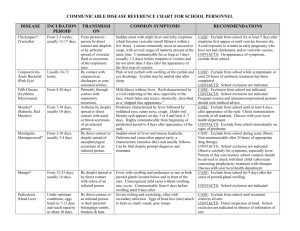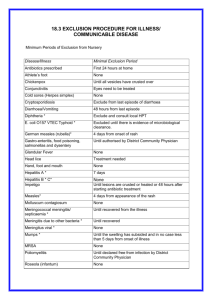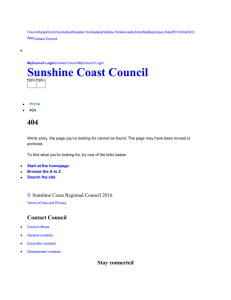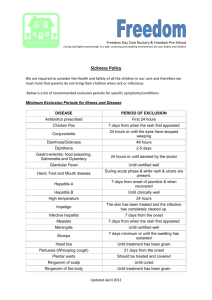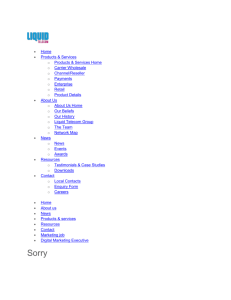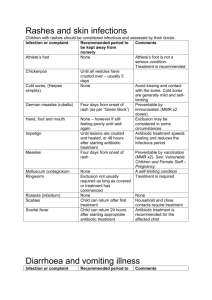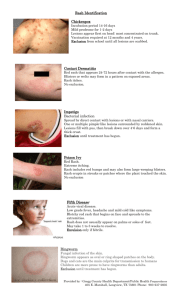COMMUNICABLE DISEASE REFERENCE CHART rev 2015
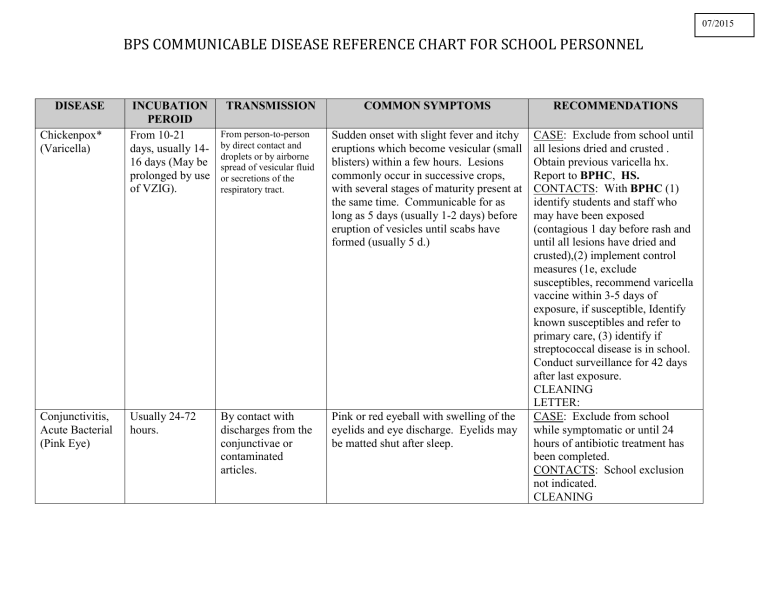
BPS COMMUNICABLE DISEASE REFERENCE CHART FOR SCHOOL PERSONNEL
DISEASE
Chickenpox*
(Varicella)
Conjunctivitis,
Acute Bacterial
(Pink Eye)
INCUBATION
PEROID
From 10-21 days, usually 14-
16 days (May be prolonged by use of VZIG).
TRANSMISSION
From person-to-person by direct contact and droplets or by airborne spread of vesicular fluid or secretions of the respiratory tract.
Usually 24-72 hours.
By contact with discharges from the conjunctivae or contaminated articles.
COMMON SYMPTOMS RECOMMENDATIONS
Sudden onset with slight fever and itchy eruptions which become vesicular (small blisters) within a few hours. Lesions commonly occur in successive crops, with several stages of maturity present at the same time. Communicable for as long as 5 days (usually 1-2 days) before eruption of vesicles until scabs have formed (usually 5 d.)
Pink or red eyeball with swelling of the eyelids and eye discharge. Eyelids may be matted shut after sleep.
CASE: Exclude from school until all lesions dried and crusted .
Obtain previous varicella hx.
Report to BPHC , HS.
CONTACTS: With BPHC (1) identify students and staff who may have been exposed
(contagious 1 day before rash and until all lesions have dried and crusted),(2) implement control measures (1e, exclude susceptibles, recommend varicella vaccine within 3-5 days of exposure, if susceptible, Identify known susceptibles and refer to primary care, (3) identify if streptococcal disease is in school.
Conduct surveillance for 42 days after last exposure.
CLEANING
LETTER:
CASE: Exclude from school while symptomatic or until 24 hours of antibiotic treatment has been completed.
CONTACTS: School exclusion not indicated.
CLEANING
07/2015
BPS COMMUNICABLE DISEASE REFERENCE CHART FOR SCHOOL PERSONNEL
DISEASE
Coxsackie
(Hand Foot and
Mouth)
Fifth Disease
(Erythema
Infectiosum)
Measles*
(Rubeola, Red
Measles)
INCUBATION
PEROID
TRANSMISSION COMMON SYMPTOMS RECOMMENDATIONS
The incubation period is 3-6 days after exposure; contagious 2 days before to 2 days after the mouth sores develop.
Contact with secretions, feces
From 4-20 days Primarily through contact with respiratory secretions.
contagious when the first symptoms appear and may continue until the blister-like skin lesions disappear. The virus has been known to be shed in the stool for up to several weeks.
LETTER
CASE; exclude until fever free
CONTACTS:no exclusion if not ill
CLEANING: regular Universal
Precautions
LETTER: not mandatory
From 7-18 days, usually 8-14 days.
Airborne by droplet spread or direct contact with nasal or throat secretions of an infected person.
Mild illness without fever. Rash characterized by a vivid reddening of the skin, especially of the face, which fades and recurs; classically, described as a
“slapped face appearance.”Frequently6 associated with lace-like rash on trunk and extremities that fades and may recur.
Prodrome characterized by fever followed by reddened eyes, runny nose, cough. Dusky-red blotchy rash appears on day 3 or 4 and lasts 4 -7 days. Highly communicable from 4 days before rash appearance to 4 days after appearance of the rash. Immunocompromised
CASE: Exclusion from school not indicated. Use standard infection control measures.
CONTACTS: School exclusion not indicated. Pregnant women and immunocompromised persons should seek medical advice.
CLEANING
LETTER
CASE: Exclude from school until at least 4 days after appearance of the rash. Check immunization records of all students.
Immediately report to BPHC and
HSA
CONTACTS: Check records of
BPS COMMUNICABLE DISEASE REFERENCE CHART FOR SCHOOL PERSONNEL
DISEASE INCUBATION
PEROID
TRANSMISSION COMMON SYMPTOMS RECOMMENDATIONS
Invasive
Meningococcal infections caused by N.
Meningitis
From 1-10 days, usually 2-4 days.
By direct contact or droplet spread of nasopharyngeal secretions of an infected person.
MRSA variable Direct contact with lesions or contaminated people can be infectious throughout illness.
May present as meningitis, bacteremia, sepsis or pneumonia. Sudden onset of fever and intense headache. Delirium and coma often appear early; a characteristic (measles-like) rash usually follows. Can be fatal despite prompt diagnosis and treatment.
Skin sores all students/staff, including volunteers, (2) implement control measures as per BPHC, (3) refer pregnant women, immunocompromised people or infants <12 months to PMD and exclude susceptibles.
Conduct surveillance for 36 days after last exposure.
CLEANING
LETTER
CASE: Immediately report to
BPHC and HS. Exclude from school during acute illness. Noncommunicable after 24 hours of appropriate drug therapy.
CONTACTS: School exclusion not indicated. Work with BPHC to identify close contacts, evaluate chemoprophylaxis indications and send parent/clinician notification letters. Conduct surveillance of
S&S for 2 wks after case.
CLEANING
LETTER
CASE: Advise to keep area covered; not necessary to exclude or notify
BPS COMMUNICABLE DISEASE REFERENCE CHART FOR SCHOOL PERSONNEL
DISEASE
Mumps
Pediculosis
(Head Lice)
Pertussis*
INCUBATION
PEROID
TRANSMISSION COMMON SYMPTOMS RECOMMENDATIONS surfaces
From 12-25 days, usually 16-
18 days.
By droplet spread or by direct contact with nasopharyngeal secretions oof an infected person.
Under optimum conditions, eggs hatch in 7-13 days and reach maturity in about
10 days.
Commonly 6-21, usually 2-10 days.
By direct contact with an infested person or their personal belongings such as combs, brushes, and hats.
By direct or droplet contact with nasopharyngeal secretions of an infected person.
Fever with swelling and tenderness or one or both parotid glands located below and in front of the ears. Unrecognized mild cases without swelling may occur.
Communicable from 7 days before swelling until 9 days after (initial day of swelling counted as day zero).
Severe itching and scratching, often with secondary infection. Eggs of head lice
(nits) attach to hairs as small, round, gray lumps.
The initial stage begins with upper respiratory symptoms and increasingly irritating cough. The paroxysmal stage usually follows within 1-2 weeks, and lasts 1-2 months. Paroxysmal stage is
CLEANING
LETTER
CASE: Report to BPHC and HS.
Exclude from school for 9 days after the onset of parotid gland swelling.
CONTACTS: School exclusion not indicated. With BPHC, 1) identify susceptibles, 2) implement control measures, 3) exclude susceptibles. Conduct surveillance for 50 days after last exposure
CLEANING
LETTER
CASE: Exclusion until nit free is
NOT indicated.
CONTACTS: Direct inspection of head. School exclusion not indicated. Full school inspection not usually recommended.
CLEANING
LETTER
CASE: Notify BPHC and HS;
.Exclude from school until 5 days after initiation of appropriate antibiotic RX, or if not treating, until 21 days from cough onset.
BPS COMMUNICABLE DISEASE REFERENCE CHART FOR SCHOOL PERSONNEL
DISEASE
Rubella*
(German
Measles)
Scabies
INCUBATION
PEROID
TRANSMISSION COMMON SYMPTOMS RECOMMENDATIONS
From 14-23 days, usually 16-
18 days.
By direct contact or droplet spread of nasopharyngeal secretions of an infected person.
From 2-6 weeks.
By direct skin-toskin contact.
characterized by repeated episodes of violent cough broken by a high-pitched inspiratory whoop. Older children may not have whoop. Convalescence may require many weeks.
Mild symptoms; slight fever, rash of variable character lasting about 3 days; enlarged head and neck lymph glands common. Joint pain may occur, especially in older children and adults.
Communicable for 7 days before onset of rash and at least 14 days thereafter.
Begins as itchy raised areas around finger webs, wrists, elbows, armpits,
CONTACTS: With BPHC: 1) identify all close contacts (direct face to face contact or nasopharyngeal secretions contact or sharing indoor space for at least
10 hrs/wk) and refer to primary care; 2) identify and asses symptomatic students; 3) implement control procedures; 4) surveillance for all school for 42 days after cough and onset of last case.
CLEANING
LETTER
CASE: Notify HS and BPHC.
Exclude from school for 7 days after onset of rash. Avoid exposure to women in early pregnancy. Check immunization records of all students. .
CONTACTS: Work with
BPHC.Those who are pregnant and not immunized should be urged to seek medical advice.
CLEANING
LETTER
CASE: Exclude from school until
24 hours of antibiotic treatment
BPS COMMUNICABLE DISEASE REFERENCE CHART FOR SCHOOL PERSONNEL
DISEASE
Shingles
Streptococcal
Diseases
(Including
Impetigo and
Scarlet Fever)
INCUBATION
PEROID
TRANSMISSION COMMON SYMPTOMS RECOMMENDATIONS
No shingles person to person transmission
BUT , if exposed person has not had varicella, may devlop chicken pox
Impetigo: variable, often 7-
10 days
Scarlet Fever: usually 1-3 days, rarely longer.
Direct skin to skin lesion contact
By direct contact with infected persons and carriers or by contact with their respiratory droplets.
belt-line, and/or genitalia. Extensive scratching often results in secondary infection.
Painful blisters; A person is not infectious before the blisters appear. Once the rash has developed crusts, the person is no longer contagious.
has been completed.
CONTACTS: Observe for signs and symptoms. School exclusion not indicated in absence of infestation.
CLEANING
LETTER
CASE: Keep area covered
CONTACTS; immunocompromised, pregnancy avoid physical contact
CLEANING
LETTER
Multiple skin lesions usually of exposed area (e.g., elbows, legs, and knees), but may involve any area. Lesions vary in size and shape, and begin as blisters, which rapidly mature into brown crusts on a reddened base. Healing from center outward produces circular areas, which may resemble ringworm.
Fever, sore throat, exudative tonsillitis or pharyngitis. Sandpaper-like rash appears most often on neck, chest, and skin folds of arms, elbows, groin, and inner aspect of thighs.
CASE: Exclude from school until lesions are healed or until 24 hours of antibiotic treatment has been completed.
CONTACTS: Exclusion from school not indicated. Observe carefully for symptoms.
CLEANING
LETTER
CASE: Observe for S&S.Exclude from school during acute illness.
Non-communicable after 24 hours of appropriate drug therapy.
CONTACTS: Exclude on first
BPS COMMUNICABLE DISEASE REFERENCE CHART FOR SCHOOL PERSONNEL
DISEASE
Tinea Corporis
(Ringworm of the Body)
INCUBATION
PEROID
Streptococcal sore throat: short, usually 1-
3 days.
Unknown but thought to be from 4-10 days.
TRANSMISSION COMMON SYMPTOMS RECOMMENDATIONS
Sudden onset of fever, sore throat, exudative tonsillitis or pharyngitis, and enlarged lymph nodes. Symptoms may even be absent in some cases.
By direct or indirect contact with lesions of an infected person or contaminated environmental surfaces.
Circular well-demarcated lesion that can involve face, trunk, or limbs. Itching is common.
indication of symptoms. Culturing of school contacts and treatment of carriers not usually indicated.
CLEANING
LETTER
CASE: Exclude from school until
24 hours of antibiotic treatment has been completed.
CONTACTS: Exclusion from school not indicated. Observe carefully for symptoms.
CLEANING
LETTER
CASE: Exclusion from school not indicated as long as lesions are covered or child is receiving treatment. During treatment, exclude from wrestling and swimming pools.
CONTACTS: School exclusion not indicated.
CLEANING
LETTER
Adapted for Boston use.
